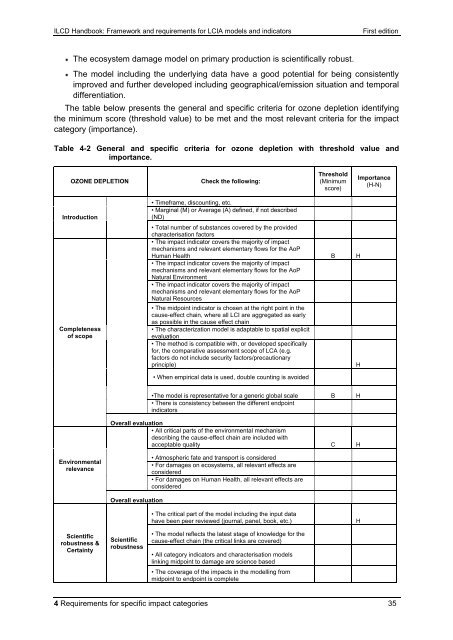ILCD Handbook: Framework and requirements for LCIA models and ...
ILCD Handbook: Framework and requirements for LCIA models and ...
ILCD Handbook: Framework and requirements for LCIA models and ...
You also want an ePaper? Increase the reach of your titles
YUMPU automatically turns print PDFs into web optimized ePapers that Google loves.
<strong>ILCD</strong> <strong>H<strong>and</strong>book</strong>: <strong>Framework</strong> <strong>and</strong> <strong>requirements</strong> <strong>for</strong> <strong>LCIA</strong> <strong>models</strong> <strong>and</strong> indicators First edition<br />
The ecosystem damage model on primary production is scientifically robust.<br />
The model including the underlying data have a good potential <strong>for</strong> being consistently<br />
improved <strong>and</strong> further developed including geographical/emission situation <strong>and</strong> temporal<br />
differentiation.<br />
The table below presents the general <strong>and</strong> specific criteria <strong>for</strong> ozone depletion identifying<br />
the minimum score (threshold value) to be met <strong>and</strong> the most relevant criteria <strong>for</strong> the impact<br />
category (importance).<br />
Table 4-2 General <strong>and</strong> specific criteria <strong>for</strong> ozone depletion with threshold value <strong>and</strong><br />
importance.<br />
OZONE DEPLETION Check the following:<br />
Introduction<br />
Completeness<br />
of scope<br />
Environmental<br />
relevance<br />
Scientific<br />
robustness &<br />
Certainty<br />
• Timeframe, discounting, etc.<br />
• Marginal (M) or Average (A) defined, if not described<br />
(ND)<br />
Threshold<br />
(Minimum<br />
score)<br />
• Total number of substances covered by the provided<br />
characterisation factors<br />
• The impact indicator covers the majority of impact<br />
mechanisms <strong>and</strong> relevant elementary flows <strong>for</strong> the AoP<br />
Human Health<br />
• The impact indicator covers the majority of impact<br />
mechanisms <strong>and</strong> relevant elementary flows <strong>for</strong> the AoP<br />
Natural Environment<br />
• The impact indicator covers the majority of impact<br />
mechanisms <strong>and</strong> relevant elementary flows <strong>for</strong> the AoP<br />
Natural Resources<br />
B H<br />
• The midpoint indicator is chosen at the right point in the<br />
cause-effect chain, where all LCI are aggregated as early<br />
as possible in the cause effect chain<br />
• The characterization model is adaptable to spatial explicit<br />
evaluation<br />
• The method is compatible with, or developed specifically<br />
<strong>for</strong>, the comparative assessment scope of LCA (e.g.<br />
factors do not include security factors/precautionary<br />
principle) H<br />
• When empirical data is used, double counting is avoided<br />
•The model is representative <strong>for</strong> a generic global scale B H<br />
• There is consistency between the different endpoint<br />
indicators<br />
Overall evaluation<br />
• All critical parts of the environmental mechanism<br />
describing the cause-effect chain are included with<br />
acceptable quality C H<br />
Overall evaluation<br />
Scientific<br />
robustness<br />
• Atmospheric fate <strong>and</strong> transport is considered<br />
• For damages on ecosystems, all relevant effects are<br />
considered<br />
• For damages on Human Health, all relevant effects are<br />
considered<br />
• The critical part of the model including the input data<br />
have been peer reviewed (journal, panel, book, etc.) H<br />
• The model reflects the latest stage of knowledge <strong>for</strong> the<br />
cause-effect chain (the critical links are covered)<br />
• All category indicators <strong>and</strong> characterisation <strong>models</strong><br />
linking midpoint to damage are science based<br />
• The coverage of the impacts in the modelling from<br />
midpoint to endpoint is complete<br />
Importance<br />
(H-N)<br />
4 Requirements <strong>for</strong> specific impact categories 35



